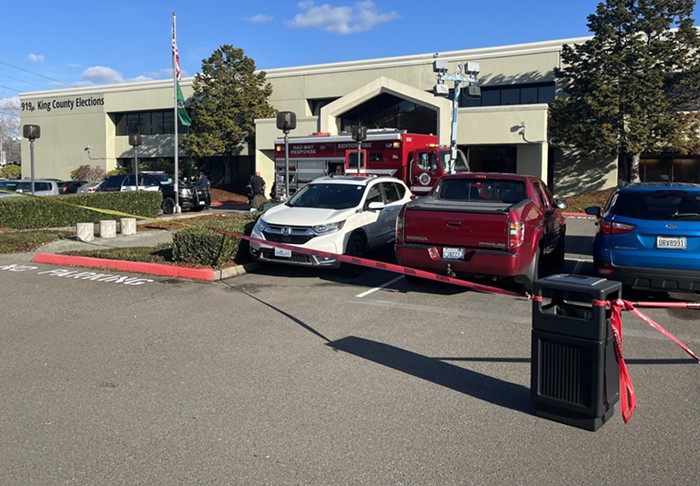"Yoo-hoo," Brown says, as if waving to her neighbors from some distant future, "it's not 1948 anymore. We've got the Growth Management Act to deal with. It makes sense to increase density in the city where there's already density and infrastructure--rather than sprawling out in Mill Creek or Issaquah."
Unfortunately for Brown, such talk is taboo in Magnolia these days, where density is a live issue: The long-abandoned 4.5-acre Briarcliff Elementary School site at 39th Avenue West and Dravus Street just south of Discovery Park is now slated for redevelopment into a housing subdivision. The developer, Lexington Fine Homes (LFH), plans to build 39 houses on the abandoned lot--currently cordoned off with a chain-link fence and distinguished by overgrown grass, crushed cans of Bud Light, a cracking blacktop surface littered with five orange traffic cones, a discarded cement staircase leading nowhere, and "DANGER! Keep Out" signs.
LFH, a high-end Bellevue-based developer, is seeking a "cluster housing" permit for the site from the city's Department of Development and Planning (DPD). Cluster housing allows construction companies to build a select number of houses on lots as small as 3,600 square feet instead of the larger regulation 5,000 square feet. This promotes density (the permit would tolerate an estimated 39 homes rather than an estimated 28 under the standard equation), allowing houses to have smaller setbacks and allowing the builder to move garages behind the homes, which brings homes closer together and closer to the sidewalk. This aesthetic is known as neo-urbanism because it mimics old-fashioned pedestrian-friendly streetscapes and promotes urban values over suburban priorities, forsaking two-car garages and large yards for close-knit porch-front communities.
However, according to the swath of protest letters sent to DPD from Magnolia, a quiet neighborhood sequestered on Seattle's mid-section peninsula west of Queen Anne, the cluster development will be "tantamount to neighborhood destruction" and will result in "trashing the neighborhood" by "converting West Viewmont Way (adjacent to the Briarcliff lot on the west) into Aurora Avenue." "What can be done to stop this invasion?" one letter asks.
"One of the great attributes of the Magnolia neighborhood," another letter states, "has always been its close proximity to a major metropolitan area, while maintaining that small and uncluttered feeling--a serene neighborhood with a village atmosphere."
This letter, written by a (Transcendentalist?) neighbor living on West Viewmont Way--a promenade of two-story brick homes set back from the street atop sloped lawns--unwittingly highlights the wisdom of Lindsay Brown's minority pro-density opinion. Living in "close proximity to the city"--Magnolia is actually part of the city, but never mind--means you have to embrace city values (like density), not run from them. Yoo-hoo! It's not 1948 anymore.
Unfortunately, the Thoreau disciple living on West Viewmont Way represents the majority. Last month, two Magnolia residents, Greg Cotter and Michele Marchi--the neighbor who said Brown "frustrated other Magnolia Community Club board members" by obstructing a vote on the Briarcliff development--setup a nonprofit called the Magnolia Action Group (MAG). They've hired a lawyer and set a goal of raising $40,000 to $50,000 to battle the development in court. (They've raised about $15,000 so far from supportive neighbors, Cotter says.)
Cotter, who believes density is "just a cover story" the developer is using to "cram pack" more houses in, lists MAG's demands: lot sizes in the development must match the 5,000-square-foot standard, the builder cannot reel in setbacks, and the streets must be up to city standards (big enough to accommodate parking and emergency vehicles) and must adhere to "neighborhood integration"--meaning 39th Avenue West must run north to south through the entire development, providing a southern exit. (Currently, there's only a plan for four northern exits onto Dravus Street--raising concerns about the extra traffic load there.) The last two demands--the call for a southern exit and the call for dedicated city streets--make sense. In fact, the city has asked the developer to widen the streets (which LFH principle John Couchenour says he's willing to do). And the city is also considering mandating the 39th Avenue West cut-through.
MAG's other two demands, however, are merely a clever legal strategy to undo the defining benefits of cluster development. If MAG succeeds in upending the Briarcliff project, the city will miss a rare opportunity to promote urban values like density.
Ironically, MAG president Marchi says she moved to Magnolia from Bothell two years ago to be "closer to the city." Last July, she editorialized in the Magnolia News: "It helps to partially define [density] in terms of those elements of the neighborhood fabric that are diminished as the density of housing increases."
While Lindsay Brown's neighbors obviously don't like her pro-density position, she's not completely alone. Aaron Ostrum, the executive director of local environmental group 1,000 Friends of Washington, sent a letter of his own to DPD on October 27 encouraging the city to give the project the green light. "If anything," Ostrum writes, "this proposal represents the minimum level of development intensity that needs to happen in cities like Seattle... if growth management is going to succeed."
The Growth Management Act, for example, requires a minimum of 4 units per acre. Dense neighborhoods like Beacon Hill average 9 units per acre in single-family zoning and Capitol Hill averages 10-12 in its single-family west side. The Briarcliff proposal would pencil out to 8.6 units per acre.
According to DPD spokesman Alan Justad, large lots like the Briarcliff subdivision plat where there's room to build more than 10 units "don't come up very often" in Seattle. "Most of our neighborhoods are built out. There's not much open land left."
The city should seize the opportunity. "If you put those extra houses here," says Brown, who's home sits on the south edge of the Briarcliff development property, "that's fewer houses in the suburbs. Less people commuting. It's more people living here, hopping on the bus, and going to work."


















